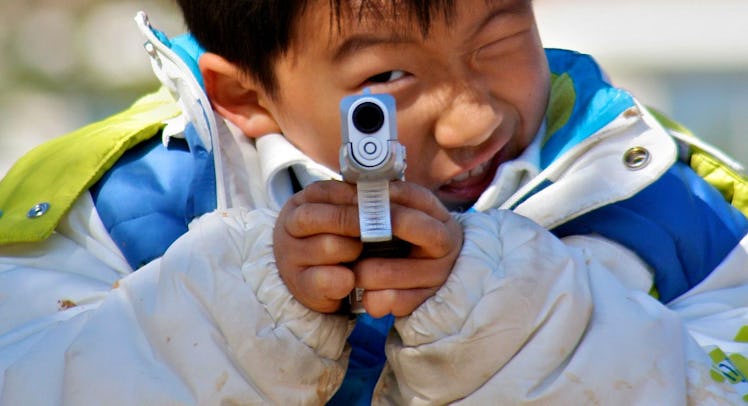The Deadly Science Behind Why Boys Love Guns
A cocktail of evolutionary urges and social zeal for firearms makes guns irresistible to boys.

There’s nothing particularly dangerous about a kid pretending to have a gun in his hand. And pretend gun play doesn’t predict whether a kid will actually take any interest in firearms as an adult. Even Nerf arsenals and guns for kids are poor predictors of future behavior, which means that advocates for fake gun control are fighting a more-or-less rhetorical battle. Gun play is, as psychologist Dr. Marjorie Sanfilippo of Eckard University is quick to point out. Just another kind of play. But just because gunplay isn’t psychologically predictive does not mean it’s not hazardous. In America, where gun accidents kill children almost daily and gun violence among young people is on the rise, it is.
Sanfilippo’s research has demonstrated that kids pretending to play with guns, while not dangerous in itself, is an indication of how drawn they are to these symbols of power and control. And boys are especially vulnerable. “Evolutionary psychologists will argue that from the beginning of time boys were the hunters and gatherers, defenders and dominant,” Sanfilippo says. “To try and fight that is probably a losing battle.” Weapons are the tools of hunting and protection, and boys are drawn to them through an instinct as old as time. At one time it was sticks as swords. Now it’s sticks as guns.
Also, a little boy lives in a world rife with men wielding weapons. Whether they’re the pew pew pew blasters of Star Wars or the massive firepower in first person shooters, getting a plastic gun in the hand makes a kid feel big and invincible. They’re suddenly able to protect the world like Dad protects Mom or the U.S. Military protects America from bad dudes. Combine this with an evolutionary bias towards hunting and protection.
The problem is that evolution is a very slow process. The progress of weapons technology is not. And many children would rather play with a real gun than a plastic rip-off. “So here it gives them a tool,” explains Sanfilippo. “They don’t have to turn a stick into a gun if they have an actual gun there they can play with.” Compounding the problem is the lack of higher executive decision making in kids. “The same 5-year-old that didn’t understand death 500 years ago when he swung a stick has become the same five-year-old that points a gun and doesn’t understand death,” Sanfilippo says.
It doesn’t help that many toy guns look like the real thing, so its conceivable that some children are initially drawn to real guns under the mistaken impression that they’re playing with a very realistic toy. One of Sanfilippo’s studies showed that, for realistic plastic facsimiles, the only way children could really tell a toy gun from a real gun was by the weight when they picked it up. “But by the time they’ve picked it up, they’ve already put themselves in danger,” she says. “I think it’s easier to tell a child ‘If it’s black or brown, don’t touch it.’”
All of this makes putting kids and guns in proximity incredibly dangerous. And Sanfilippo’s research suggests that there’s not that much to mitigate that danger aside from making sure they are never in the same place at the same time. “Gun safety courses are fairly ineffective,” she says. “And the danger of those types of programs is that they make parents more complacent.” One of her studies randomly placed children in gun education classes, which they completed before they were placed in a room with a gun. She found that children who had taken the classes were no less likely than other kids to avoid playing with the gun.
The bottom line? Kids are naturally—and perhaps evolutionarily—drawn to guns. Education and warnings cannot fight that. Which means, ultimately, it’s the parent’s responsibility to keep guns out a child’s hands.
“Keep real guns away from you children,” she says. “Period.”